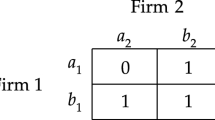Abstract
We propose a model of an agent’s probability and utility that is a compromise between Savage (The foundations of statistics, Wiley, 1954) and Jeffrey (The Logic of Decision, McGraw Hill, 1965). In Savage’s model the probability–utility pair is associated with preferences over acts which are assignments of consequences to states. The probability is defined on the state space, and the utility function on consequences. Jeffrey’s model has no consequences, and both probability and utility are defined on the same set of propositions. The probability–utility pair is associated with a desirability relation on propositions. Like Savage we assume a set of consequences and a state space. However, we assume that states are comprehensive, that is, each state describes a consequence, as in Aumann (Econometrica 55:1–18, 1987). Like Jeffrey, we assume that the agent has a preference relation, which we call desirability, over events, which by definition involves uncertainty about consequences. For a given probability and utility of consequences, the desirability relation is presented by conditional expected utility, given an event. We axiomatically characterize desirability relations that are represented by a probability–utility pair . We characterize the family of all the probability–utility pairs that represent a given desirability relation.


Similar content being viewed by others
Notes
This is done with almost no loss of generality as by the Stone Theorem, Stone (1936), every Boolean algebra is isomorphic to the Boolean algebra of a family of subsets.
Axiom P6\('\) is imposed on a qualitative probability relation on events. Here, it is imposed on the desirability relation on events. Axiom P6 is a translation of P6\('\) for a preference relation on acts.
The symmetric difference of two events consists of all the states in these events that do not belong to both, that is, \(A\Delta B=(A\cup B)\setminus (A\cap B)=(A\setminus B)\cup (B\setminus A)\).
A probability measure P is non-atomic if for each event E and \(\alpha \) in [0, 1], there exists an event \(F\subseteq E\) such that \(P(F)=\alpha P(E)\). This condition appeared first in Savage (1954) and was described as non-atomicity by Machina and Schmeidler (1992). Gilboa (1987) defined an extension of this condition to non-additive measures, and referred to a measure that satisfies it as convex ranged.
It is straightforward to see that Likelihood-ratio dominance implies stochastic dominance.
References
Ahn, D. S. (2008). Ambiguity without a state space. The Review of Economic Studies, 75, 3–28.
Aumann, R. (1987). Correlated equilibrium as an expression of Bayesian rationality. Econometrica, 55, 1–18.
Bolker, E. D. (1966). Functions resembling quotients of measure. Transactions of the American Mathematical Society, 2, 292–312.
Bolker, E. D. (1967). A simultaneous axiomatization of utility and subjective probability. Philosophy of Science, 34(4), 273–298.
Carlaw, K. I., Lipsey, R. G., & Webb, R. (2007). Has the ICT Revolution Run its Course?, Discussion Papers dp07-18. Department of Economics: Simon Fraser University.
Chai, J., Li, C., Wakker, P. P., Wang, T. V., & Yang, J. (2016). Reconciling savage’s and Luce’s modeling of uncertainty: The best of both worlds. Journal of Mathematical Psychology, 75, 10–18.
de Finetti, B. (1931). Sul significato soggettivo della probabilita. Fundamenta Mathematicae, 17, 298–329.
Gilboa, I. (1987). Expected utility with purely subjective non-additive probabilities. Journal of Mathematical Economics, 16, 65–88.
Jeffrey, R. (1965). The logic of decision. New York: McGraw Hill.
Jeffrey, R. (1983). The logic of decision. Chicago: The University of Chicago Press.
Luce, R. D., & Krantz, D. H. (1971). Conditional expected utility. Econometrica, 39, 253–271.
Machina, M. J., & Schmeidler, D. (1992). A more robust definition of subjective probability. Econometrica, 60, 745–780.
Savage, L. J. (1954). The foundations of statistics. New York: Wiley.
Stone, M. H. (1936). The theory of representation for Boolean algebras. Transactions of the American Mathematical Society, 40, 37–111.
Telpaz, A., & Levy, D. J. (2015). Consumers. Future choices. Journal of Marketing Research, 52, 511–529.
von Neumann, J., & Morgenstern, O. (1953). Theory of games and economic behavior (3rd ed.). Princeton: Princeton University Press.
Webb, R., Levy, I., Lazzaro, S. C., Rutledge, R. B., & Glimcher, P. W. (2019). Neural random utility: Relating cardinal neural observables to stochastic choice behaviour. Journal of Neuroscience, Psychology, and Economics, 12, 45–72.
Acknowledgements
Dov Samet acknowledges financial support of ISF Grant #722/18.
Author information
Authors and Affiliations
Corresponding author
Additional information
Publisher's Note
Springer Nature remains neutral with regard to jurisdictional claims in published maps and institutional affiliations.
Rights and permissions
About this article
Cite this article
Samet, D., Schmeidler, D. Desirability relations in Savage’s model of decision making. Theory Decis 94, 1–33 (2023). https://doi.org/10.1007/s11238-022-09883-y
Accepted:
Published:
Issue Date:
DOI: https://doi.org/10.1007/s11238-022-09883-y




